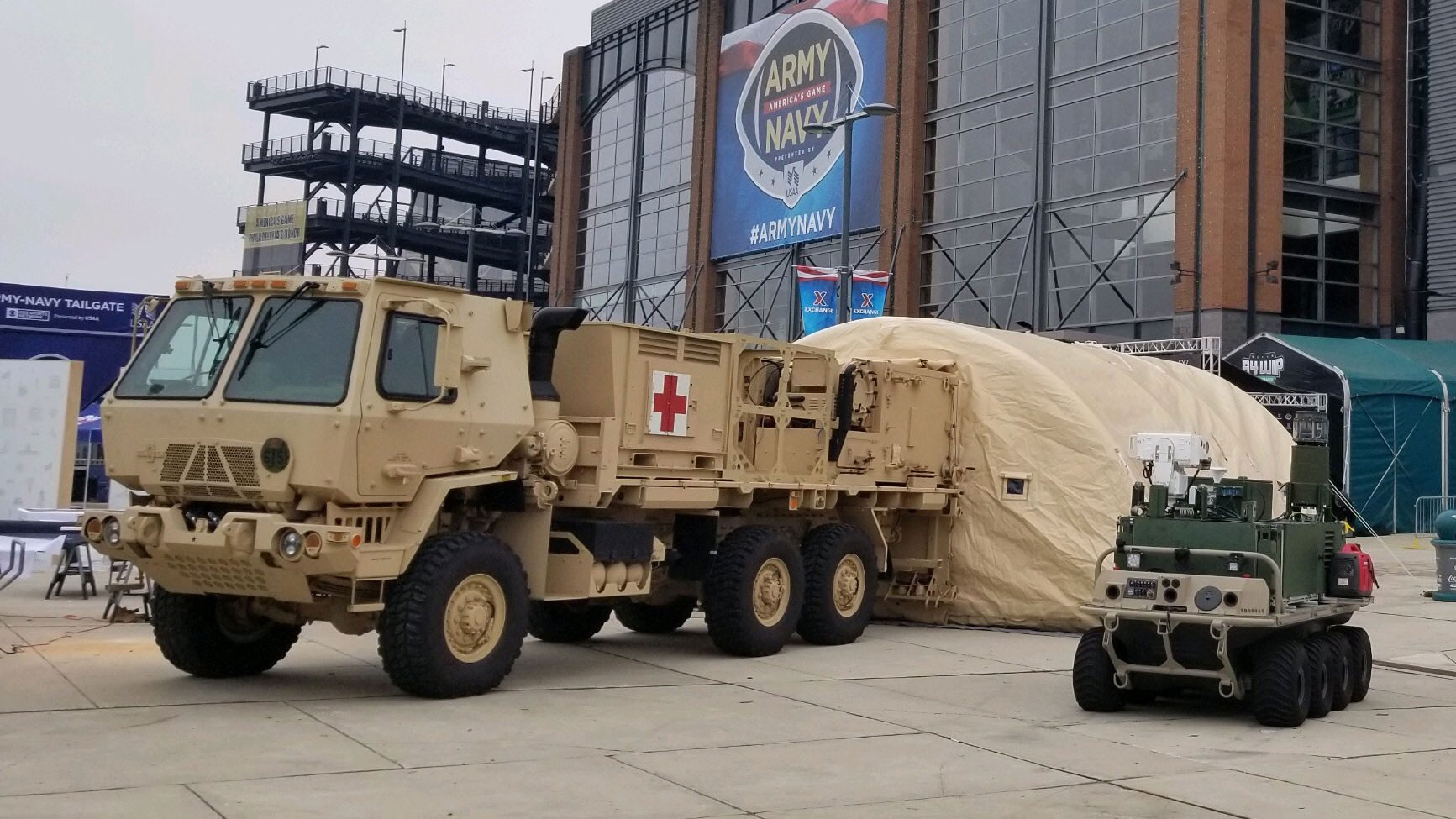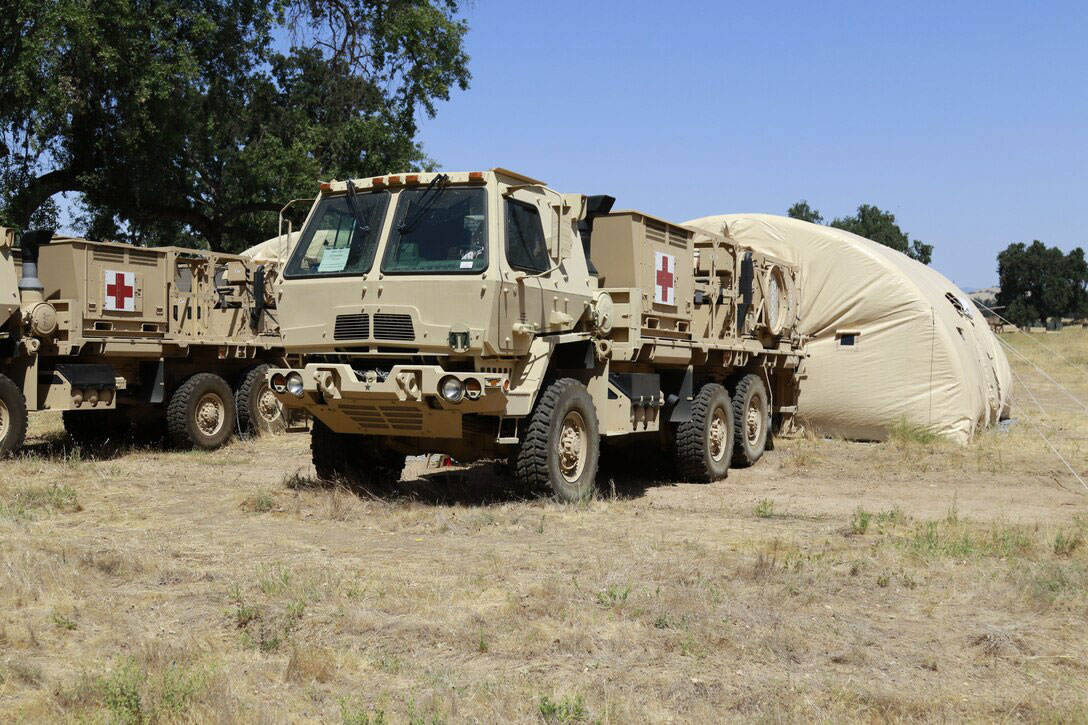
HERE TO HELP: A combat medic with the 135th Area Support Medical Company, Pfc. Nicole Atkinson, drives a Chemical Biological Protective Shelter M8E1 Light Medium Tactical Vehicle on March 25 while preparing for potential COVID-19 response missions in Waukesha, Wisconsin. (Photo by Spc. Emma Anderson, Wisconsin National Guard)
The Chemical Biological Protective Shelter acquisition program produces the final shelter, making way for modernization.
by Gregg Buehler
After more than 20 years of production, the Chemical Biological Protective Shelter (CBPS) program has produced its last system. The shelter is a mobile, self-contained, rapidly deployable, chemically and biologically protected shelter that provides a contamination-free, environmentally controlled medical treatment facility for U.S. Army Role I and II medical units. (In DOD’s “Emergency War Surgery,” there are five levels, or roles, of care. Role I is the lowest and provides immediate first aid on the scene. Role II increases the capabilities and includes limited inpatient care. Role V is the highest.)
The shelter is versatile enough to be used by field surgeons, physician assistants and field medics for initial triage, medical treatment and possible evacuation. The shelter does not provide the medical equipment that is used for treatment. It provides the shelter, the heating, ventilation and cooling equipment, the chemical, biological, radiological and nuclear filtration equipment, generators for powering the system components, means for storage of standard Army medical equipment sets, and the vehicle used for transportation and mobility.

SHOWING OFF: The CBPS on display at the 2019 Army-Navy football game. (Photo by Stephen Lusher, Joint Program Executive Office for Chemical, Biological, Radiological and Nuclear Defense)
GIMME (BETTER) SHELTER
Production of the first variant began in 1999, which provided medical shelter system support to the Army and Marine Corps units in the then-active conflicts in Iraq and Kuwait. In 2006, the development of the second variant commenced to address user requests for added capability. Production of the second variant began in 2010 and continued through 2020.
Recent shifts in Army modernization priorities ended CBPS production in order to redirect funding to these higher priority efforts.
The CBPS effort began in the late 1980s in response to the need for a replacement for the 1960s-era M51 Collective Protection Shelter (CPS) system. The trailer-mounted M51 suffered from excessive deployment time requirements, minimal floor space in which to perform medical operations, and a lack of a dedicated prime mover. Often, the M51 CPS trailer would simply be left behind in the motor pool since military units lacked enough available vehicles to tow the trailer into the conflict area. The CBPS effort addressed these issues by designing an integrated system that was mounted on a Humvee, which could be quickly deployed, provided its own on-board system power generation, increased the usable floor space, and increased overall system reliability.
CBPS development activities concluded in the late 1990s with the completion of the CBPS M8 design.

PANDEMIC RESPONSE: Sgt. Michelle Baum, a combat medic with the 135th Area Support Medical Company, walks next to a Chemical Biological Protective Shelter M8E1 Light Medium Tactical Vehicle on March 25 while instructing a U.S. Army Motor Vehicle Operator’s test in preparation for potential COVID-19 response missions in Waukesha, Wisconsin. (Photo by Spc. Emma Anderson, Wisconsin National Guard)
A CHANGE OF PLATFORMS
The CBPS M8 variant entered limited-rate, urgent production in the late 1990s and provided systems to support ongoing operations in the Middle East at the time, where it saw usage in medical, command and control, and several other applications. Designed as a rapidly deployable medical shelter system, CBPS provided a contamination free, environmentally controlled medical shelter where U.S. Army medical personnel could treat patients in a chemical-biological contamination environment without the encumbrance of wearing chemical-biological personal protective equipment, such as mission-oriented protective posture gear.
The program entered full-rate production in 2002, eventually producing 197 CBPS M8 systems that were globally deployed to Army units. Lessons learned from these deployments and the ongoing conflicts’ emerging improvised explosive device threat resulted in the program transitioning from the Humvee-mounted CBPS M8 variant to the current CBPS M8E1 design.
The CBPS M8E1 variant is mounted on a Medium Tactical Vehicle to provide ballistic protection for the crew while in mobile operations to counter the improvised explosive device threat. The CBPS M8E1 design further increased the shelter’s usable floor space while simultaneously improving the systems filtration, environmental control, power generation and load carrying capabilities.
The transition between active production of the CBPS M8 variant to development of the CBPS M8E1 variant occurred in the mid-2000s, with commercial production of the CBPS M8E1 design beginning in 2010. In 2016, deliveries from the commercial contract ceased and an organic manufacturing capability was established at Pine Bluff Arsenal, Arkansas.
At the conclusion of CBPS-M8E1 production in the 2020 fiscal year, the CBPS program had produced a total of 299 CBPS M8E1 variants. The majority of these systems have been fielded in locations both inside and outside the continental United States, with the remainder ready to be fielded once the base-closure and travel restrictions imposed by the global COVID-19 pandemic are lifted.
For more than 20 years, the CBPS program produced 496 CBPS systems that provide the warfighter with a clean, toxin-free workspace in which medical operations could be performed during both normal operations as well as during chemical and biological contaminated events. Without the CBPS system, the Army would have no means of providing medical operations in a chemical and biological contaminated environment.
Now that the CBPS program production has ended, the program will transition to sustainment. The overall system sustainment activities transition to the Tank-Automotive & Armaments Command‘s Integrated Logistics Support Command, Chemical and Biological Defense Product Support Integration Directorate – Collective Protection and Decon Team in Warren, Michigan. Support for the system’s control system software package is provided by the Armament Software Engineering Center at Picatinny Arsenal, New Jersey. The acquisition program’s staff will move on to other programs and functions.

SYSTEM UPGRADED: A Chemical Biological Protective Shelter M8E1 sits fully deployed by the 628th Forward Surgical Team out of Fort Sam Houston, Texas, on a training site during Global Medic exercise July 13 at Fort Hunter Liggett, California. The shelter’s design increased its usable floor space and improved systems filtration, environmental control, power generation and load carrying capabilities. (Photo by Spc. Justin Snyder, U.S. Army Reserve)
For more information, go to https://asc.army.mil/web/portfolio-item/cbd-chemical-biological-protective-shelter-cbps-m8e1/.
GREGG BUEHLER is the product manager for the Chemical Biological Protective Shelter in the Office of the Joint Project Manager for Protection (JPM Protection), Combat Capabilities Development Command – Soldier Center. He has a M.S. in materials system engineering from Worcester Polytechnic Institute (2010) and a B.S. in mechanical engineering from the University of Massachusetts – Dartmouth (1994). He is Level III certified in both program management and engineering.
Read the full article in the Spring 2021 issue of Army AL&T magazine.
Subscribe to Army AL&T – the premier source of Army acquisition news and information.
![]()







